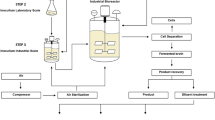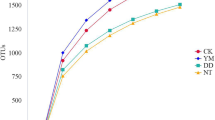Abstract
In situ bioremediation of oily sludge-contaminated soil by biostimulation of indigenous microbes through adding manure was conducted at the Shengli oilfield in northern China. After bioremediation for 360 days, total petroleum hydrocarbon (TPH) content was reduced by 58.2% in the treated plots compared with only 15.6% in the control plot. Moreover, bioremediation significantly improved the physicochemical properties of the soil in the treated plot. Soil microbial counts and community-level physiological profiling were also examined. Manure addition increased TPH degraders and polycyclic aromatic hydrocarbon (PAH) degraders in the contaminated soil by one to two orders of magnitude. The activity and biodiversity of soil microbial communities also increased markedly in the treated plot compared with that of the control. Finally, biotoxicity was used to evaluate the soils and a sharp increase in the EC50 of the soil after bioremediation was observed, indicating that bioremediation had reduced the toxicity of the soil.


Similar content being viewed by others
References
Atlas, R. M. (1984). Petroleum microbiology. New York: Macmillan Publishing Company.
Balba, M. T., Awadhi, N., & Al-Daher, R. (1998). Bioremediation of oil-contaminated soil: Microbiological methods for feasibility assessment and field evaluation. Journal of Microbiological Methods, 32, 155–164. doi:10.1016/S0167-7012(98)00020-7.
Bello, Y. M. (2007). Biodegradation of Lagoma crude oil using pig dung. African Journal of Biotechnology, 6, 2821–2825.
Bronwyn, D. H., Raymond, L. C., Wendy, M., Clive, A. K., & Clive, E. P. (1997). Using the Gini coefficient with BIOLOG substrate utilization data to provide an alternative quantitative measure for comparing bacterial soil communities. Journal of Microbiological Methods, 30, 91–101. doi:10.1016/S0167-7012(97)00048-1.
Bundy, J. G., Paton, G. I., & Campbell, C. D. (2004). Combined microbial community level and single species biosensor responses to monitor recovery of oil polluted soil. Soil Biology and Biochemistry, 36, 1149–1159. doi:10.1016/j.soilbio.2004.02.025.
Ding, K. Q., Luo, Y. M., & Sun, T. H. (2002). Bioremediation of soil contaminated with petroleum using forced-aeration composting. Pedosphere, 12, 145–150.
Garland, J. L., Mills, A. L., & Young, J. S. (2001). Relative effectiveness of kinetic analysis vs single point readings for classifying environmental samples based on community-level physiological profiles (CLPP). Soil Biology and Biochemistry, 33, 1059–1066. doi:10.1016/S0038-0717(01)00011-6.
Grazyna, P., Grzegorz, N. C. B., Krzysztof, U., & Robin, L. B. (2005). The application of bioassays as indicators of petroleum-contaminated soil remediation. Chemosphere, 59, 289–296. doi:10.1016/j.chemosphere.2004.11.049.
Hinchee, R. E., Fredrickson, J., & Alleman, B. C. (Eds.). (1995). Bioremediation: When is augmentation needed. In Bioaugmentation for site remediation. Columbus, OH: Battelle Press.
Jorgensen, K. S., Puustinenn, J., & Suortti, A. M. (2000). Bioremediation of petroleum hydrocarbon-contaminated soil by composting in biopiles. Environmental Pollution, 107, 245–254. doi:10.1016/S0269-7491(99)00144-X.
Liu, W. X., Luo, Y. M., Teng, Y., Li, Z. G., & Wu, L. H. (2006). Eco-risk assessment & bioremediation of petroleum contaminated soil II. Changes in physico-chemical properties and microbial ecology of petroleum contaminated soil. Acta Pedologica Sinica, 43, 461–466.
Lu, R. K. (Ed.). (1999). Analytical method of soil agricultural chemistry. Beijing: China Agricultural Science and Technology Press.
Mana Capelli, S., Busalmen, J. P., & Desanchez, S. R. (2001). Hydrocarbon bioremediation of a mineral-base contaminated waste from crude oil extraction by indigenous bacteria. International Biodeterioration and Biodegradation, 47, 233–238. doi:10.1016/S0964-8305(01)00050-6.
Mishra, S., Jyot, J., Kuhad, R. C., & Lal, B. (2001). Evaluation of inoculum addition to stimulate in situ bioremediation of oily-sludge-contaminated soil. Applied and Environmental Microbiology, 67, 1675–1681. doi:10.1128/AEM.67.4.1675-1681.2001.
Mrayyan, B., & Battikhi, M. N. (2005). Biodegradation of total organic carbons (TOC) in Jordanian petroleum sludge. Journal of Hazardous Materials, 120, 127–134. doi:10.1016/j.jhazmat.2004.12.033.
Norhayati, A., Sinnappah-Kang, N.D., Juliana, S., & Nordin, M. (2002). Effects of selective logging on amphibian biodiversity and abundance in the sungai weng sub-catchment, ulu muda forest reserve. Proceedings of the Regional Symposium on Environment and Natural Resources, 1, 313–322.
Rahman, K. S. M., Banat, I. M., Thahira, J., Thayumanavan, T., & Lakshmanaperumalsamy, P. (2002). Bioremediation of gasoline contaminated soil by a bacterial consortium amended with poultry litter, coir pith and rhamnolipid biosurfactant. Bioresource Technology, 81, 25–32. doi:10.1016/S0960-8524(01)00105-5.
Sabat’e, J., Vinas, M., & Solanas, A. M. (2004). Laboratory-scale bioremediation experiments on hydrocarbon-contaminated soils. International Biodeterioration and Biodegradation, 54, 19–25. doi:10.1016/j.ibiod.2003.12.002.
Salanitro, J. P., Dorn, P. B., Huesemann, M. H., Moore, K. O., Rhodes, I. A., Jackson, L. M., et al. (1997). Crude oil hydrocarbon bioremediation and soil ecotoxicity assessment. Environmental Science and Technology, 31, 1769–1776. doi:10.1021/es960793i.
Smalla, K., Wachtendorf, U., Heuer, H., Liu, W., & Forney, L. (1998). Analysis of Biolog GN substrate utilization patterns by microbial communities. Applied and Environmental Microbiology, 64, 1220–1225.
Ting, Y. P., Hu, H. L., & Tan, H. M. (1999). Bioremediation of petroleum hydrocarbons in soil microcosms. Resource and Environmental Biotechnology, 2, 197–218.
Trindade, L. G., Sobral, A. C. L., Rizzo, S. G. F., Leite, P. V. O., & Soriano, A. U. (2005). Bioremediation of a weathered and a recently oil-contaminated soils from Brazil: A comparison study. Chemosphere, 58, 515–522. doi:10.1016/j.chemosphere.2004.09.021.
USEPA. (1986). Test Method for Evaluating Solid Waste, SW-846 (3rd edn., Vol. 1A). DC: Washington.
Venosa, A. D., Suidan, M. T., Wrenn, B. A., Strohmeier, K. L., Haines, J. R., Eberhart, B. L., et al. (1997). Bioremediation of an experimental oil spill on the shoreline of Delaware Bay. Environmental Science and Technology, 30, 1764–1775. doi:10.1021/es950754r.
Wrenn, B. A., & Venosa, A. D. (1996). Selective enumeration of aromatic and aliphatic hydrocarbon degrading bacteria by a most-probable-number procedure. Canadian Journal of Microbiology, 42, 252–258.
Wuensche, L., Brueggemann, L., & Babel, W. (1995). Determination of substrate utilization patterns of soil microbial communities: An approach to assess population changes after hydrocarbon pollution. FEMS Microbiology Ecology, 17, 295–306.
Acknowledgements
The authors would like to thank the Knowledge Innovation Project of the Institute of Soil Science CAS (ISSASIPO0724), the Program of Innovative Engineering of the Chinese Academy of Sciences (CXTD-Z2005-4), and the International Cooperation Program of the Chinese Ministry of Science and Technology (2006DFA91940), which provided financial support for this work, and Mr. Jian Zhang of Shengli oilfield for help in building and managing the field for bioremediation.
Author information
Authors and Affiliations
Corresponding author
Rights and permissions
About this article
Cite this article
Liu, W., Luo, Y., Teng, Y. et al. Bioremediation of oily sludge-contaminated soil by stimulating indigenous microbes. Environ Geochem Health 32, 23–29 (2010). https://doi.org/10.1007/s10653-009-9262-5
Received:
Accepted:
Published:
Issue Date:
DOI: https://doi.org/10.1007/s10653-009-9262-5




